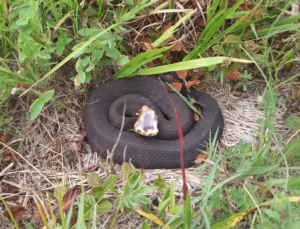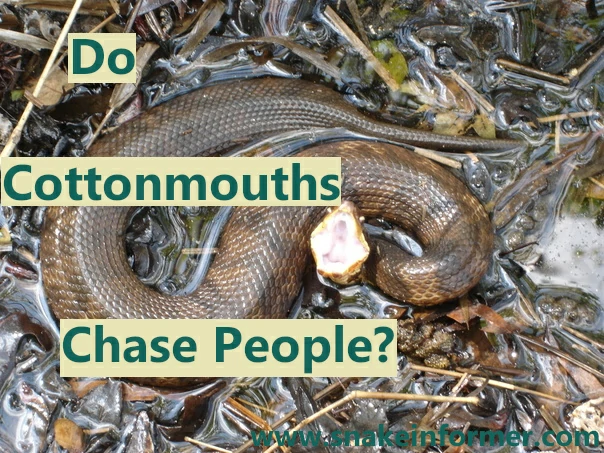Cottonmouths ( also known as water moccasins ) are stocky snakes, found in the southeastern United States. One common belief about these snakes is that they are very aggressive, even to the point of “chasing” people. But is there any truth to this?
Cottonmouths do not actually chase people. These snakes are defensive, but not aggressive, and would rather escape than confront an attacker. The idea that cottonmouths chase people is a myth, rooted in a misunderstanding of their behavior.
When threatened, a cottonmouth will usually attempt to retreat to the nearest cover, regardless of who is in the way.
Sometimes, the closest cover is in the direction of a person, and the snake will flee toward a person – often accompanied by a raised head and an open mouth, to scare the intruder out of the way.
This behavior is entirely defensive but may be misinterpreted as aggression or chasing.
The snake is really just trying to get to cover, and the person is in its way.
Cottonmouth Snakes Are Not Aggressive
Cottonmouth snakes are not aggressive and avoid direct contact with humans.
Like many snakes, they rely on camouflage as a first line of defense. Their dark coloration helps them blend in with their surroundings and avoid detection by potential predators.
When approached, these snakes usually remain completely still, relying on camouflage to avoid being seen.
Their camouflage is so good that you might walk right past a hidden cottonmouth without realizing it.
If the snake feels it has been detected, it may attempt to flee the closest cover, be it water, or vegetation.
When escape is not an option, the cottonmouth will stand its ground and defend itself by coiling its body, while opening its mouth – to expose the white lining.

It may also release a foul-smelling musk from glands at the base of the tail, to deter the attacker.
Cottonmouths only strike as a last resort, when they feel they are in immediate danger and have no other choice.
Their bites are highly venomous, and require immediate medical attention.
Cottonmouth Snakes Do Not Chase People
Cottonmouth snakes do not chase people in the predators as bears do.
As earlier mentioned, what people interpret as “chasing” is usually a defensive reaction.
A frightened cottonmouth may flee in the direction of a person, if it is the only route to escape to cover.
However, this is an intentional chase – the snake is just trying to escape to safety, and the person is in its way.
If a cottonmouth is startled and you’re between it and the nearest cover, it might move in your direction as it tries to flee.
For example, a cottonmouth snake near a pond may escape into the water to avoid potential predators.
If you get between the water and the snake, the snake may move in your direction – and seem as though it is chasing you.
In reality, the startled snake is just trying to get to the water to avoid human contact, and you are in its path.
Cottonmouth snakes are shy and prefer to be left alone – rather than confront humans.
What to Do if You Encounter a Cottonmouth Snake
Cottonmouth snakes are venomous, but this does not mean they are a danger to humans.
These snakes are not aggressive, and will only strike as the last resort to defend themselves.
If you ever encounter a cottonmouth snake in the wild, follow these simple safety tips
1. Stay Calm
Stay calm and realize that the snake sees you as a predator, that is trying to harm it.
Sudden movements can startle the snake and increase the likelihood of a defensive reaction.
2. Give the Snake Space
Back away and realize that you are invading the snake’s space (not the other way around).
If the snake moves towards you, move to one side, and let it go where it wants to go.
Cottonmouths only react aggressively when they are cornered.
3. Do Not Try to Handle the Snake
The majority of venomous snake bites in the US happen when people have already seen a snake, but try to interact with it rather than just moving away.
Trying to handle a Cottonmouth snake is dangerous and unnecessary.
It’s best to leave the snake alone and move on.
4. Watch Your Step
Stay on trails and avoid tall grass or thick vegetation.
It’s also very important to watch your step, especially around water, logs, or thick brush – so you don’t encounter any other snakes.
Conclusion
Cottonmouths are misunderstood creatures that have many myths surrounding them.
These snakes are not aggressive and heavily rely on defense to survive attackers.
These snakes do not chase people, and would rather be left alone than pick a fight with a human.
If you encounter a cottonmouth in the wild, it may move in your direction as it attempts to flee – but this is entirely defensive.
Be calm, respect its space, and remember that the snake is not out to get you.
Understanding the behavior of cottonmouth snakes is an essential part of peacefully coexisting with these creatures.
Hi, my name is Ezra Mushala, i have been interested animals all my life. I am the main author and editor here at snakeinformer.com.

